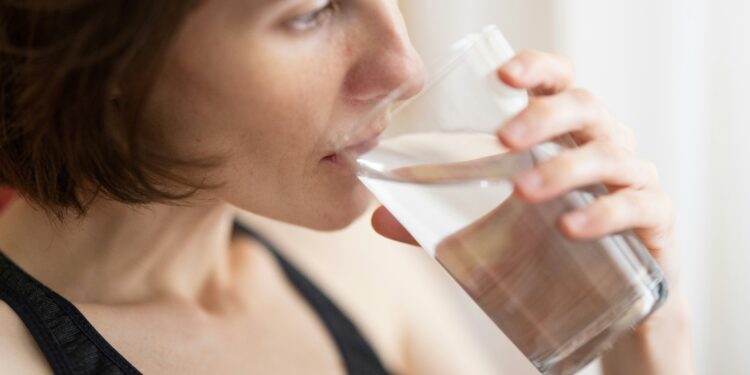Walk through any office, airport terminal, or yoga studio in the West and you’ll likely find someone gripping a water bottle with a zeal once reserved for religious relics. We are, by all accounts, a well-hydrated people—yet millions still report an unquenchable thirst.
This persistent sensation of thirst, often brushed off as a minor nuisance or lifestyle misstep, might instead reflect a complex interplay of flawed public health messaging, unacknowledged medical conditions, and a beverage industry that has quietly profited from our confusion. Behind every parched mouth may lie a deeper story: one where the simple act of drinking water becomes entangled in larger systems of misinformation and exploitation.
The Medical Puzzle: When Hydration Advice Becomes Misdirection
Medical professionals have long touted the “eight glasses a day” rule, despite the lack of rigorous evidence supporting it. According to a 2002 review published in the American Journal of Physiology, the origins of this rule are vague at best and largely unscientific.
More recently, newer hydration philosophies have emerged, particularly in wellness circles—many emphasizing electrolyte balance, bioavailability of fluids, and timing. Still, despite this evolving discourse, patients complaining of chronic thirst often encounter dismissive attitudes.
“People come in saying they drink three liters of water a day and still feel thirsty, and they’re told to drink more,” says Dr. Shreya Bhatt, an endocrinologist based in Chicago. “But excessive thirst can be a sign of diabetes, kidney dysfunction, or even rare conditions like diabetes insipidus. And yet, it’s frequently brushed aside.”
Dr. Bhatt adds that diagnostic inertia is part of the problem. With overburdened primary care physicians operating under tight time constraints, subtle but significant symptoms like persistent thirst often don’t trigger in-depth investigation.
The Profit Motive: Bottled Water, Wellness Fads, and Dehydration by Design
Consider the bottled water industry. It is projected to hit $509 billion by 2030, according to Statista. At its core is a paradox: it thrives on the narrative that we’re all perpetually dehydrated, despite ample access to clean drinking water in much of the Global North.
Beverage companies—especially those selling enhanced or electrolyte-infused waters—have quietly rebranded water as a product requiring constant optimization. From “alkaline hydration” to “biocharged H2O,” the promise is clear: if you’re still thirsty, you’re not drinking the right water.
“It’s classic manufactured demand,” says marketing analyst Jennifer Cole, who spent a decade advising beverage startups. “You can’t sell water unless people believe they’re not getting enough of it—or the kind they’re drinking isn’t good enough.”
These companies aren’t just selling water; they’re selling anxiety. Apps that monitor your fluid intake, smart bottles that glow to remind you to sip, and fitness influencers who tout personalized hydration regimens feed into the broader tech-wellness complex.
What’s often overlooked in this narrative is that persistent thirst might not be due to a lack of intake at all—it might stem from a body that’s inefficient at retaining fluids.
The Salt in the Wound: Modern Diets and Electrolyte Imbalance
Processed foods dominate the average Western diet, and with them comes a tidal wave of sodium and added sugars. High salt intake alters the body’s ability to regulate hydration at a cellular level, triggering a feedback loop of thirst—even as the bloodstream remains chemically overloaded.
Moreover, sugar-sweetened beverages, which many mistakenly consume as a substitute for water, further exacerbate dehydration. Glucose requires water to be metabolized, and sugary drinks—despite their liquid form—often dehydrate rather than hydrate.
Electrolyte imbalance, though typically associated with extreme exercise or illness, is becoming more common in sedentary populations due to diet, medication, and poor hydration habits. Ironically, drinking too much water without replenishing sodium and potassium can worsen this imbalance.
“There’s a misconception that more water is always better,” says Dr. Evan Laramie, a nephrologist at a public hospital in Detroit. “But water without adequate electrolytes can dilute your plasma and disrupt key cellular functions. You can feel more thirsty as a result.”
Tech Interventions and the Quantified Self
Technology has gamified hydration. Wearable devices and AI-driven apps now promise to optimize water intake based on real-time biometrics. While these innovations may offer genuine benefits for some—particularly athletes and those with chronic illness—they also reinforce a growing societal obsession with micro-optimization.
But is this digital quantification actually solving the problem?
A study published in Nature Digital Medicine found that most hydration apps overestimated daily water needs and did not adjust adequately for dietary water intake or local climate. “There’s a disconnect between algorithmic logic and physiological nuance,” said one of the authors, Dr. Maya Lintz.
Thirst and Mental Health: The Psychological Dimensions
Emerging research suggests a surprising overlap between chronic thirst and mental health conditions like anxiety, depression, and somatic symptom disorder. These links are not yet fully understood but indicate that some experiences of thirst may be neurologically or psychologically mediated.
One theory posits that chronic low-grade anxiety can heighten awareness of bodily sensations—including dry mouth or the urge to drink. In such cases, thirst may not be a sign of physical dehydration, but a psychosomatic feedback loop driven by stress and hypervigilance.
“This doesn’t mean it’s ‘all in your head,’” cautions psychiatrist Dr. Lena O’Connor. “But it does mean we need a more holistic model—one that acknowledges both physiological and emotional dimensions of thirst.”
Policy Implications: From Public Health to Urban Planning
The politics of thirst extend beyond individuals. Urban planning decisions—from the availability of public water fountains to policies around sugary beverage taxation—shape how communities experience hydration. In many U.S. cities, public drinking fountains are broken, hard to find, or altogether absent, pushing residents toward commercial beverage options.
And while corporate responsibility campaigns tout hydration education, few address the systemic issues at play: lack of access to medical screening, misleading advertising, or poor nutritional guidance at the population level.
“We’ve privatized hydration,” says health policy expert Allison Marks. “And in doing so, we’ve made it both a personal responsibility and a lucrative business model.”
Conclusion: A New Paradigm for an Old Sensation
The next time you feel thirsty, consider this: your body might not just be asking for water—it might be sounding the alarm on a deeper imbalance, or reacting to a culture that’s commodified even its most basic needs.
Persistent thirst is not a weakness, nor is it a puzzle easily solved by drinking more water. It’s a signal—a complex, often misunderstood one—that deserves more than wellness platitudes or hydration hacks. It deserves investigation, empathy, and systemic change.















